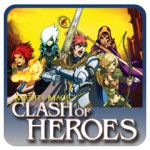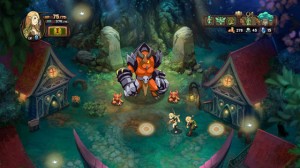 Its rare to find a game whose gameplay can’t be summed up with either a single sentence of exposition, or by explaining how its like two other games fused together. For example, Final Fantasy Tactics takes the turn based combat of the original Fire Emblem and adds some of the accoutrements of the Final Fantasy series. Puzzle Quest uses the mechanics of a match 3 game like Bejewelled and layers on traditional RPG elements. The fact that you cannot possibly explain or pigeonhole Clash of Heroes in this way shows how unique it really is.
Its rare to find a game whose gameplay can’t be summed up with either a single sentence of exposition, or by explaining how its like two other games fused together. For example, Final Fantasy Tactics takes the turn based combat of the original Fire Emblem and adds some of the accoutrements of the Final Fantasy series. Puzzle Quest uses the mechanics of a match 3 game like Bejewelled and layers on traditional RPG elements. The fact that you cannot possibly explain or pigeonhole Clash of Heroes in this way shows how unique it really is.
Developed by Capybara games, this spin-off from the main Might and Magic series was originally a DS game and this port shows its hand-held heritage. Although the animated sequences and cut scenes don’t look bad, they seem low detail and childlike. Its worse once the game begins with some of the characters looking more like place holder art. Getting over the budget feel of the game caused by the generic fantasy music and stylised-but-basic visuals will be the first hurdle for most gamers to cross before they start enjoying the game. It doesn’t help that each battle is punctuated by the terrible story which is full of tired, sub-Tolkein tropes and acted out by lifeless stereotypes. An elf Princess called “Anwen”? Seriously? The game may exist in Might and Magic continuity and as a result, the storyline may be of interest to fans of the series, but to everyone else it will be something they skip past quickly to get to the gameplay.
Once you escape the dull dialogue and cut scenes and enter the game proper you begin to realise how devious and involving Clash of Heroes really is. Although tied together by an overworld map with a series of nodes that you travel between, its the battles with random enemies that take place as you move from point to point that make up the meat of the game.
 So what exactly does the gameplay involve? Well, its essentially a competitive puzzle game. A random selection of your units appear in a grid at the bottom of the screen while your enemies units appear in a different grid at the top. Each turn you have a set number of moves you can make to shift your units to new positions. You can only take units from the bottom of a row, and by combining three of the same colour in a column you form an attacking column that will damage your enemy after a set number of turns depending on the unit type. Once triggered, the attack will either damage facing enemy units or make it all the way to the back row of the enemy grid, in which case it will damage their overall hit points. Reduce their hit points to zero and you win.
So what exactly does the gameplay involve? Well, its essentially a competitive puzzle game. A random selection of your units appear in a grid at the bottom of the screen while your enemies units appear in a different grid at the top. Each turn you have a set number of moves you can make to shift your units to new positions. You can only take units from the bottom of a row, and by combining three of the same colour in a column you form an attacking column that will damage your enemy after a set number of turns depending on the unit type. Once triggered, the attack will either damage facing enemy units or make it all the way to the back row of the enemy grid, in which case it will damage their overall hit points. Reduce their hit points to zero and you win.
Layered on to this are numerous special rules and complexities. Building a row of three similar coloured units instead of a column will turn them into a defensive wall. Deleting a unit will cause the empty space to be filled as the other units “fall ” to replace them allowing more ways for threes to be matched. Building multiple columns of similar coloured units will cause their damage to multiply. Clicking one of the triggers will pull in reinforcements as all the units you’ve lost will return to the field. Special units will jump walls or cast spells or attack in particular directions. All of these complexities make what begins as a superficially simple game fantastically deep and complex. In many ways the fundamental gameplay shares some mechanics with a card battler like Magic: The Gathering with the different unit types having as many special abilities and characteristics as a deck of random cards.
 While the main story and overworld map provides items to find and story events, it’s the grid based combat that really drives everything. Facing a high level enemy (your character levels up and each opponent has a skill level too) is exhilarating and challenging. The game is hard and these challenging boss-type battles are the finest parts of the game. I found that every time I lost I would like the game a little more. I was forced to learn more about the gameplay systems and develop my own tactics and fine-tune my army. To say its a compulsive, engrossing experience would be an understatement.
While the main story and overworld map provides items to find and story events, it’s the grid based combat that really drives everything. Facing a high level enemy (your character levels up and each opponent has a skill level too) is exhilarating and challenging. The game is hard and these challenging boss-type battles are the finest parts of the game. I found that every time I lost I would like the game a little more. I was forced to learn more about the gameplay systems and develop my own tactics and fine-tune my army. To say its a compulsive, engrossing experience would be an understatement.
Clash of Heroes is a hard game to rate. Its absorbing and insanely deep, but the visuals are bad and the story is terrible. Its a port of a handheld game, and its heritage shows in every part of the presentation. Despite all that, its a game that manages to be as engrossing and interesting as the very best puzzle games, but is also completely original. Its rare that a game is so unique that I can’t sum up its gameplay in just a few words, and its rarer still to find such a game that’s this good.
8 genre defying mind-melting puzzles out of 10
